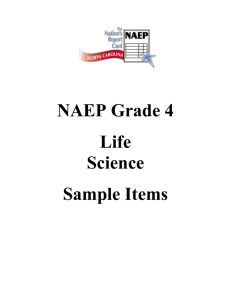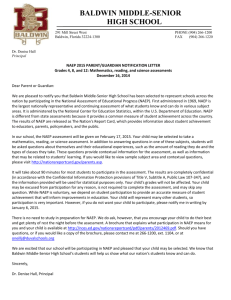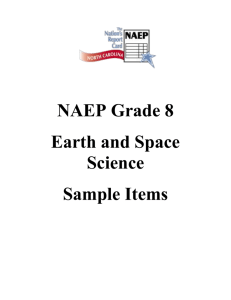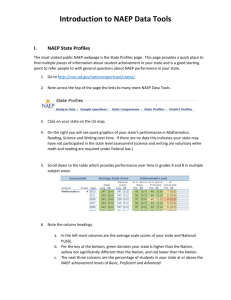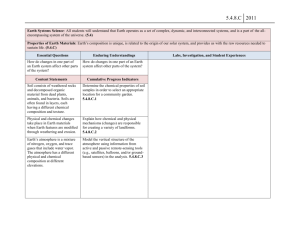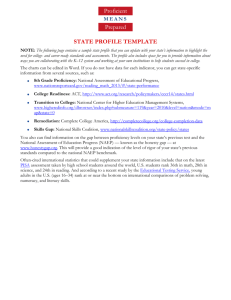Figure 1
advertisement
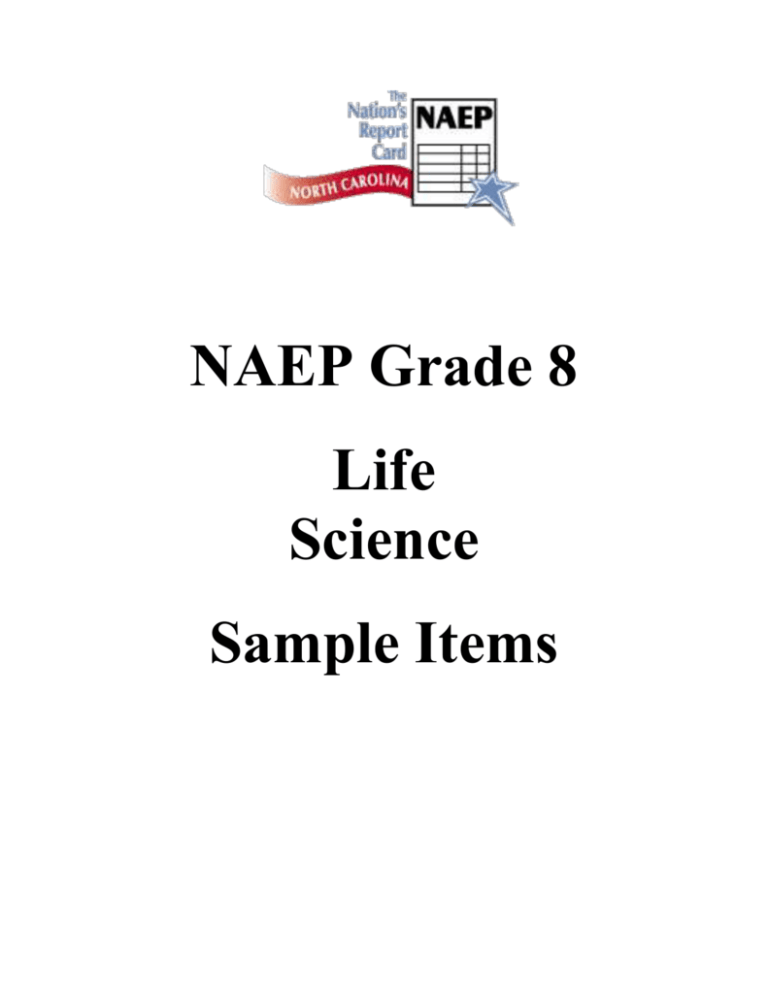
NAEP Grade 8 Life Science Sample Items National Assessment of Educational Progress (NAEP) Released Items Grade 8 Life Science Figure 1 The picture below shows a pond ecosystem. Use this picture and what you know about the things in it to answer the questions in this section. Question 1 refers to Figure 1 1. Which of the following living things in the pond system uses the energy from sunlight to make its own food? A) Insect B) Frog C) Water lily D) Small fish SOURCE: NAEP Questions Tool; http://nces.ed.gov/nationsreportcard/itmrls/ M. Hickman, NAEP State Coordinator, North Carolina Department of Public Instruction 1 National Assessment of Educational Progress (NAEP) Released Items Grade 8 Life Science Question 2 refers to Figure 1 2. Each of the animals in the pond needs food. What are two things that the animals get from their food that keep them alive? Question 3 refers to Figure 1 3. In the pond, small fish eat algae. What two predators might eat the small fish in the pond system? Question 4 refers to Figure 1 4. You will now finish a diagram of a food web in the pond. The food web shows what eats what in the pond system. Draw arrows in the diagram below from each living thing to the things that eat it. (The first arrow is drawn for you.) Question 5 refers to Figure 1 5. Which living things in the pond system break down dead plants and animals? A) Green algae B) Bacteria C) Rushes D) Frogs SOURCE: NAEP Questions Tool; http://nces.ed.gov/nationsreportcard/itmrls/ M. Hickman, NAEP State Coordinator, North Carolina Department of Public Instruction 2 National Assessment of Educational Progress (NAEP) Released Items Grade 8 Life Science Question 6 refers to Figure 1 6. Tell why it is important for dead animals and plants in the pond system to be broken down. Question 7 refers to Figure 1 7. Which animal is the top carnivore in the pond system? Explain why you chose this answer. Question 8 refers to Figure 1 8. If all of the small fish in the pond system died one year from a disease that killed only the small fish, what would happen to the algae in the pond? Explain why you think so. What would happen to the large fish? Explain why you think so. Question 9 refers to Figure 1 9. Suppose that one spring a new type of large fish was put into the pond. So many were put in that there were twice as many fish as before. By the end of the summer, what would happen to the large fish that were already in the pond? Explain why you think these new large fish would have this effect. SOURCE: NAEP Questions Tool; http://nces.ed.gov/nationsreportcard/itmrls/ M. Hickman, NAEP State Coordinator, North Carolina Department of Public Instruction 3 National Assessment of Educational Progress (NAEP) Released Items Grade 8 Life Science Question 10 refers to Figure 1 10. If a rainstorm washed some fertilizer from a nearby field into the pond, what would happen to the algae in the pond system after one month? Why do you think the fertilizer would affect the algae this way? Question 11 refers to Figure 1 11. What effect would the fertilizer have on the bacteria in the mud at the bottom of the pond after one month? Why do you think the fertilizer would affect the bacteria this way? Question 12 refers to Figure 1 12. If air pollution causes the rain that falls on this pond to become much more acidic, after two years how will this acidity affect the living things in this pond? A) There will be more plants and animals because the acid is a source of food. B) There will be fewer plants and animals because the acid will dissolve many of them. C) There will be fewer plants and animals because many of them cannot survive in water with high acidity. D) There will be more plants and animals because the acid will kill most of the disease-causing microorganisms. Question 13 refers to Figure 1 13. Suppose that a farmer near the pond sprayed crops with a pesticide to kill insects and that some of the spray washed into the pond. (This pesticide breaks down very slowly.) If several months later a biologist tested all the organisms in the pond system for the pesticide, which organism would most likely have the greatest concentration of the pesticide? Explain your answer. SOURCE: NAEP Questions Tool; http://nces.ed.gov/nationsreportcard/itmrls/ M. Hickman, NAEP State Coordinator, North Carolina Department of Public Instruction 4 National Assessment of Educational Progress (NAEP) Released Items Grade 8 Life Science 14. A potted plant can survive in a sealed glass container for a long time, but you would not put a mouse in such a sealed container for even a short period of time because it would quickly die. Explain why the plant can survive and the mouse cannot. 15. In the human body the digestion of proteins takes place primarily in which two organs? A) Mouth and stomach B) Stomach and small intestine C) Liver and gall bladder D) Pancreas and large intestine 16. Which group of organisms would all be found living in a tropical rain forest? A) Lizards, insects, cacti, kangaroos B) Vines, palm trees, tree frogs, monkeys C) Evergreens, moose, weasels, mink D) Lichens, mosses, caribou, polar bears 17. A significant percentage of the United States population is overweight. List two factors in our American lifestyle that put people in the United States at greater risk for becoming overweight than people who live in other countries. SOURCE: NAEP Questions Tool; http://nces.ed.gov/nationsreportcard/itmrls/ M. Hickman, NAEP State Coordinator, North Carolina Department of Public Instruction 5 National Assessment of Educational Progress (NAEP) Released Items Grade 8 Life Science 18. Classify each of the eight living things listed below into one of two groups according to an important physical characteristic. Gorilla Parrot Snake Earthworm Jellyfish Sponge Fish Fly Group 1 Group 2 What physical characteristic did you use in your classification? Name a different physical characteristic that you could have used. 19. Which of the following is most consistent with the modern theory of evolution? A) Parents pass their physical traits to their offspring; those offspring with traits that help them survive in the environment are able to reproduce. B) Parents change their physical traits in order to survive in the environment, then those parental traits are passed to their offspring. C) Life on this planet came from another planet far out in space. D) Living organisms have not changed for hundreds of millions of years. 20. A woman uses alcohol and other drugs in excess during pregnancy. Explain how the alcohol and other drugs could affect her baby. SOURCE: NAEP Questions Tool; http://nces.ed.gov/nationsreportcard/itmrls/ M. Hickman, NAEP State Coordinator, North Carolina Department of Public Instruction 6 National Assessment of Educational Progress (NAEP) Released Items Grade 8 Life Science 21. Using a microscope, Linh observes some paramecia in a drop of pond water on a slide. She notices that the paramecia move faster in the area where the light is brightest than they do in an area where the light is less bright. Linh hypothesizes that the paramecia are trying to get away from the light. Describe what she could do to test her hypothesis. SOURCE: NAEP Questions Tool; http://nces.ed.gov/nationsreportcard/itmrls/ M. Hickman, NAEP State Coordinator, North Carolina Department of Public Instruction 7 National Assessment of Educational Progress (NAEP) Released Items Grade 8 Life Science 22. Bacteria and laboratory animals are sometimes used by scientists as model organisms when researching cures for human diseases such as cancer. Describe one possible advantage and one possible disadvantage of using bacteria as models to help find cures for human diseases. Advantage: Disadvantage: Describe one possible advantage and one possible disadvantage of using laboratory animals such as mice, guinea pigs, and monkeys as models to help find cures for human diseases. Advantage: Disadvantage: SOURCE: NAEP Questions Tool; http://nces.ed.gov/nationsreportcard/itmrls/ M. Hickman, NAEP State Coordinator, North Carolina Department of Public Instruction 8

